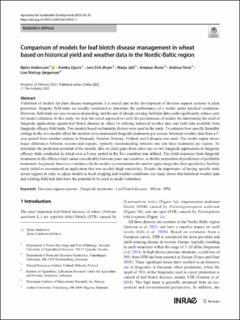| dc.contributor.author | Andersson, Björn | |
| dc.contributor.author | Djurle, Annika | |
| dc.contributor.author | Ørum, Jens Erik | |
| dc.contributor.author | Jalli, Marja | |
| dc.contributor.author | Ronis, Antanas | |
| dc.contributor.author | Ficke, Andrea | |
| dc.contributor.author | Jørgensen, Lise Nistrup | |
| dc.date.accessioned | 2022-09-21T08:17:37Z | |
| dc.date.available | 2022-09-21T08:17:37Z | |
| dc.date.created | 2022-08-25T11:03:50Z | |
| dc.date.issued | 2022-05-23 | |
| dc.identifier.citation | Agronomy for Sustainable Development. 2022, 42 (3), . | en_US |
| dc.identifier.issn | 1774-0746 | |
| dc.identifier.uri | https://hdl.handle.net/11250/3020101 | |
| dc.description.abstract | Validation of models for plant disease management is a crucial part in the development of decision support systems in plant protection. Bespoke field trials are usually conducted to determine the performance of a model under practical conditions. However, field trials are very resource-demanding, and the use of already existing field trial data could significantly reduce costs for model validation. In this study, we took this novel approach to verify the performance of models for determining the need of fungicide applications against leaf blotch diseases in wheat by utilising historical weather data and yield data available from fungicide efficacy field trials. Two models based on humidity factors were used in the study. To estimate how specific humidity settings in the two models affect the number of recommended fungicide treatments per season, historical weather data from a 5-year period from weather stations in Denmark, Sweden, Norway, Finland, and Lithuania was used. The model output shows major differences between seasons and regions, typically recommending between one and three treatments per season. To determine the prediction potential of the models, data on yield gains from either one or two fungicide applications in fungicide efficacy trials conducted in wheat over a 5-year period in the five countries was utilised. The yield responses from fungicide treatments in the efficacy trials varied considerably between years and countries, as did the proportion of predictions of profitable treatments. In general, there was a tendency for the models to overestimate the need to apply fungicides (low specificity), but they rarely failed to recommend an application that was needed (high sensitivity). Despite the importance of having specific trials across regions in order to adjust models to local cropping and weather conditions, our study shows that historical weather data and existing field trial data have the potential to be used in model validation. | en_US |
| dc.language.iso | eng | en_US |
| dc.publisher | Springer Nature | en_US |
| dc.rights | Navngivelse 4.0 Internasjonal | * |
| dc.rights.uri | http://creativecommons.org/licenses/by/4.0/deed.no | * |
| dc.title | Comparison of models for leaf blotch disease management in wheat based on historical yield and weather data in the Nordic-Baltic region | en_US |
| dc.title.alternative | Comparison of models for leaf blotch disease management in wheat based on historical yield and weather data in the Nordic-Baltic region | en_US |
| dc.type | Peer reviewed | en_US |
| dc.type | Journal article | en_US |
| dc.description.version | publishedVersion | en_US |
| dc.rights.holder | © The Author(s) 2022 | en_US |
| dc.source.pagenumber | 11 | en_US |
| dc.source.volume | 42 | en_US |
| dc.source.journal | Agronomy for Sustainable Development | en_US |
| dc.source.issue | 3 | en_US |
| dc.identifier.doi | 10.1007/s13593-022-00767-7 | |
| dc.identifier.cristin | 2045923 | |
| dc.source.articlenumber | 42 | en_US |
| cristin.ispublished | true | |
| cristin.fulltext | original | |
| cristin.qualitycode | 1 | |

